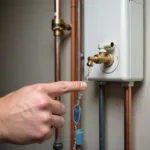Your car’s roof edge might seem like a small detail, but it plays a significant role in protecting your vehicle from the elements. A properly sealed roof edge prevents water, dust, and debris from entering the passenger compartment, causing damage or corrosion. If you notice water leaks or your roof edge seal appears damaged, it’s crucial to take action and address the issue.
What Does “Sealing the Roof Edge” Mean and Why Is It Important?
“Sealing the roof edge” refers to the process of renewing or repairing the seal along your car’s roof edge. This seal is typically made of a durable, waterproof material like rubber or silicone and is designed to create a tight closure between the roof and the car body.
A well-sealed roof edge offers a number of benefits:
- Protection from Water Damage: One of the main reasons for sealing the roof edge is to prevent water from entering the vehicle interior. Water ingress can lead to a range of problems, including damage to the interior, mold growth, and even electrical issues.
- Rust Prevention: If water penetrates through a leaking roof edge, it can accumulate in body cavities and promote rust formation. Rust can compromise your vehicle’s structural integrity and lead to costly repairs.
- Improved Sound Insulation: The seal at the roof edge also contributes to the vehicle’s sound insulation. A well-sealed roof edge can help reduce wind and road noise, resulting in a quieter and more comfortable ride.
How to Recognize a Leaky Roof Edge?
There are several signs to look for to determine if your car’s roof edge needs sealing:
- Water Leaks: The most obvious sign of a leaky roof edge is water entering the passenger compartment, especially after rain or car washes. Look for damp spots on the headliner, pillars, or in the footwells.
- Visible Seal Damage: Carefully inspect the seal along the roof edge for cracks, holes, detachments, or other damage. Over time, the seal can become brittle or damaged due to sun exposure, extreme temperatures, and wear and tear.
- Wind Noise: If you notice excessive wind noise while driving, especially at higher speeds, it could indicate a leaky or damaged roof edge seal.
How Can I Seal the Roof Edge?
The procedure for sealing the roof edge depends on the severity of the problem and your DIY skills.
Minor Leaks can often be fixed yourself with sealant. There are special sealants for car bodies available commercially that are suitable for this purpose. Thoroughly clean the affected area, apply the sealant according to the manufacturer’s instructions, and allow it to cure completely.
For more significant damage or if you are not comfortable with the repair yourself, you should consult a professional, such as a car repair shop or a body shop. They have the necessary expertise and tools to properly seal the roof edge and ensure your vehicle is optimally protected from the elements again.
Tips for Preventing Future Roof Edge Seal Problems
- Regular Inspection: Regularly inspect the seal along your car’s roof edge for signs of damage.
- Cleaning: Clean the seal regularly with a damp cloth and a mild detergent.
- Protection: Use a sealant protectant to maintain the seal’s elasticity and protect it from UV rays and other harmful environmental influences.
Conclusion
A well-sealed roof edge is essential to protect your car from water damage, rust, and other issues. If you notice signs of a leaky roof edge, you should address the problem as soon as possible. With a little attention and care, you can help ensure your car’s roof edge seal remains in good condition and your vehicle is optimally protected.
Do you have further questions about “sealing the roof edge” or need help with the repair? Feel free to contact us! Our car experts are here to help you with advice and assistance.

